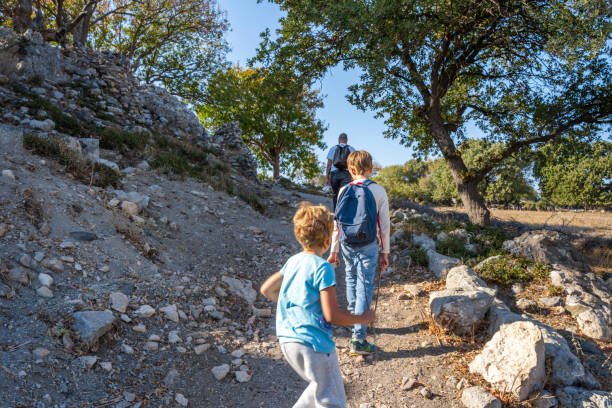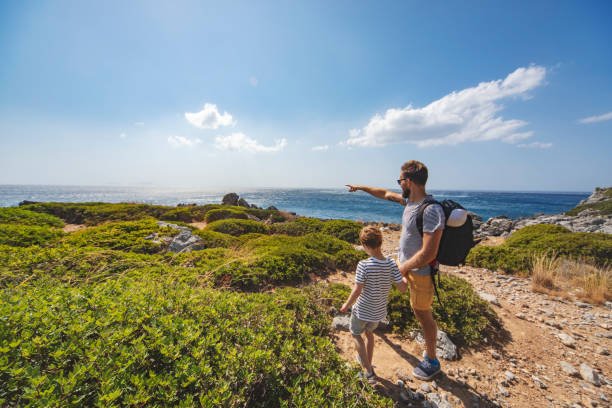Adventurous Family Travel
This post contains affiliate links. I may earn a commission at no extra cost to you if you make a purchase. Note that I’m not a health or outdoor safety professional, so further research is advised. Your support keeps TravelHealthyBlog running—thank you! Read the full disclosure. Read the full disclosure here.
In a world brimming with screens and schedules, the call for adventurous family travel echoes as a beacon of possibility, inviting families to step outside their comfort zones and into a realm of shared exploration. Adventurous family travel transcends the ordinary, weaving a tapestry of experiences that linger in the hearts and minds of each family member. This guide embarks on a journey into the world of adventurous family travel, where the pursuit of new horizons and the thrill of discovery become catalysts for building enduring bonds.
Cultivating an Adventurous Mindset as a Family

As we delve into the heart of adventurous family travel, it’s not just about choosing destinations that boast adrenaline-pumping activities; it’s about fostering a mindset that values curiosity, resilience, and the joy of shared exploration. The adventure begins not at the destination but within the family itself. Encouraging children to embrace curiosity and cultivating a love for exploration lay the foundation for a family that seeks adventure in both the extraordinary and the everyday.
Practical Tips for Adventurous Family Planning
Adventure and practicality need not be mutually exclusive. Balancing the thrill of the unknown with careful planning is key to ensuring a seamless and enjoyable adventure for the entire family.
From setting realistic expectations for trips with children to researching family-friendly adventure destinations, this section will unravel practical tips that pave the way for memorable and stress-free family adventures.
Buckle up as we navigate the terrain of adventurous family travel, discovering the transformative power of shared exploration and the magic that unfolds when families embrace the spirit of adventure together.
Cultivating an Adventurous Mindset as a Family

The essence of adventurous family travel lies not just in the destinations visited but in the mindset cultivated within the family unit. Nurturing a sense of adventure in children from an early age lays the groundwork for a lifetime of curiosity and open-mindedness. Here are key aspects to consider when fostering an adventurous mindset as a family:
1. Encouraging Curiosity and a Love for Exploration in Children:
- Foster a culture of questioning and exploration, encouraging children to ask “why” and seek answers.
- Provide opportunities for hands-on learning, whether it’s exploring nature, trying new activities, or engaging in creative projects.
2. Embracing a Mindset that Values Experiences Over Possessions:
- Shift the family narrative towards valuing experiences and shared adventures over material possessions.
- Discuss and celebrate the memories created during past adventures, reinforcing the idea that experiences hold enduring value.
3. Incorporating Adventure into Everyday Life:
- Infuse a sense of adventure into daily routines, from trying new recipes to exploring local parks.
- Embrace the unknown even in small ways, fostering a mindset where change and exploration are welcomed.
By prioritizing curiosity, valuing experiences, and making adventure a part of everyday life, families can create a foundation that sets the stage for transformative and meaningful journeys.
Practical Tips for Adventurous Family Planning

Embarking on an adventurous family trip requires a delicate balance between spontaneity and thoughtful preparation. Here are practical tips to guide families in planning and executing memorable adventures:
1. Set Realistic Expectations for Adventurous Trips with Children:
- Consider the ages and interests of your children when planning activities, ensuring they are age-appropriate and enjoyable.
- Be realistic about the pace of the trip, allowing time for rest and flexibility in the itinerary.
2. Research Family-Friendly Adventure Destinations:
- Explore destinations that offer a spectrum of adventurous activities suitable for different age groups.
- Look for family-friendly accommodations and facilities that cater to the unique needs of traveling with children.
3. Prepare for Various Challenges and Be Adaptable:
- Anticipate challenges such as changing weather, unexpected detours, or minor mishaps.
- Pack essentials like a first aid kit, snacks, and entertainment to mitigate unexpected situations.
4. Involve Children in Planning:
- Encourage children to contribute to the trip planning process, allowing them to choose activities or destinations that spark their interest.
- Discuss the upcoming adventure as a family, creating a sense of anticipation and shared excitement.
5. Create a Flexible Itinerary:
- Develop a loose itinerary that includes a mix of planned activities and free time for spontaneous discoveries.
- Remain open to unexpected opportunities, allowing the family to pivot and explore new possibilities.
As you embark on planning your adventurous family journey, remember that a well-thought-out approach enhances the overall experience without stifling the thrill of the unknown.
Destinations Ideal for Adventurous Families
The world is a vast playground waiting to be explored, and for adventurous families, choosing the right destination is key to crafting an enriching experience. Here, we unveil destinations that cater to various interests and age groups, providing a canvas for unforgettable family adventures:
1. National Parks and Wildlife Reserves:

- Explore the wonders of national parks, where families can embark on hikes, wildlife safaris, and educational nature walks.
- Discover the diverse ecosystems, from the Grand Canyon in the United States to the Serengeti in Tanzania, offering an immersive experience in nature.
2. Outdoor Adventure Hubs:
- Choose destinations known for outdoor activities like rafting, zip-lining, and rock climbing.
- Adventure hubs such as Queenstown in New Zealand or Interlaken in Switzerland provide a plethora of options for families seeking an adrenaline rush.
3. Cultural Immersions in Unique Locales:
- Immerse your family in the rich tapestry of cultures by exploring cities known for their history, art, and traditions.
- From Kyoto in Japan to Marrakech in Morocco, these destinations offer a blend of adventure and cultural exploration.
4. Local and International Exploration:
- Consider both local and international destinations based on the scope of your family’s adventurous spirit.
- Local road trips can be as thrilling as international escapades, offering the chance to uncover hidden gems in your own backyard.
5. Islands and Coastal Adventures:

- Discover the allure of islands, where families can engage in water sports, beachcombing, and marine exploration.
- Coastal destinations like the Great Barrier Reef in Australia or the Azores in Portugal provide a perfect backdrop for water-centric adventures.
As we traverse the globe through these diverse destinations, the aim is to cater to every family member’s interests, creating a tapestry of experiences that blend excitement, education, and cultural enrichment.
Adventurous Activities for Families with Children
Embarking on an adventurous family journey requires tailoring activities to cater to the diverse interests and energy levels of children. Here are exhilarating activities that promise engagement and joy for every member of the family:

1. Adventure Sports for Thrill-Seekers:
- Consider adventure sports such as zip-lining, white-water rafting, or even bungee jumping.
- Seek destinations that offer age-appropriate versions of these activities, ensuring safety while maximizing the thrill.
2. Nature Exploration and Hiking:
- Venture into the great outdoors with family-friendly hikes in national parks or nature reserves.
- Engage children with nature exploration, identifying flora and fauna along the way, fostering an appreciation for the environment.
3. Cultural Scavenger Hunts:
- Turn cultural exploration into an interactive scavenger hunt, with clues leading the family to historical landmarks or hidden gems.
- This activity not only entertains but also educates, offering insights into the local history and culture.
4. Creative Outdoor Play:
- Encourage creative outdoor play by bringing along art supplies for nature-inspired crafts or journaling.
- Build sandcastles on the beach, create nature art installations, or engage in other imaginative activities that connect children with their surroundings.
5. Wildlife Safaris and Animal Encounters:
- Plan visits to wildlife reserves or zoos that offer educational and interactive experiences.
- Engage in guided safaris to observe animals in their natural habitat, sparking curiosity about the animal kingdom.
6. Camping Under the Stars:

- Foster a love for the outdoors by incorporating camping into your adventurous itinerary.
- Whether in a national park or a designated camping site, sleeping under the stars enhances the sense of adventure and connection with nature.
By tailoring activities to align with the interests and energy levels of every family member, you not only create lasting memories but also instill a love for adventure that transcends generations.
Balancing Safety and Adventure
While the thrill of adventure is enticing, ensuring the safety of every family member is paramount. Striking the right balance between excitement and security is the key to a successful and worry-free family adventure. Here are essential considerations to maintain a safe yet exhilarating journey:

1. Anticipate Challenges and Prepare Accordingly:
- Conduct thorough research on your chosen destination, identifying potential challenges such as weather changes, terrain difficulties, or health concerns.
- Pack essentials like a first aid kit, medications, and emergency contact information to address unexpected situations.
2. Choose Age-Appropriate Activities:
- Select activities that align with the age and physical capabilities of each family member.
- Ensure that adventure sports and excursions have suitable options for children, providing a balance between excitement and safety.
3. Prioritize Qualified Guides and Instructors:
- When engaging in adventure sports or guided tours, choose reputable providers with experienced guides.
- Verify certifications and reviews to ensure the competence and reliability of instructors.
4. Maintain Open Communication:
- Foster open communication within the family about safety protocols and emergency procedures.
- Establish a meeting point in case of separation and discuss safety guidelines with children to ensure their awareness.
5. Incorporate Educational Elements:
- Integrate educational components into adventurous activities, helping children understand potential risks and safety measures.
- Teach basic navigation skills, wildlife awareness, and environmental responsibility to instill a sense of responsibility during adventures.
6. Be Adaptable to Changing Circumstances:
- Remain flexible in your plans, especially in the face of unexpected changes in weather, closures, or other unforeseen circumstances.
- Prioritize safety over sticking to a rigid itinerary, adjusting plans as needed to ensure the well-being of the family.
By embracing adventure with a safety-first mindset, families can savor the excitement of exploration while mitigating risks.
Involving Children in Planning
Empowering children with a sense of involvement in the travel planning process not only sparks excitement but also cultivates a deeper appreciation for the adventure ahead. Here’s how to engage children in the planning phase and ensure that the family itinerary caters to their interests:

1. Encourage Input and Preferences:
- Foster a sense of ownership by encouraging children to express their preferences for activities and destinations.
- Discuss their interests and incorporate their ideas into the overall plan, whether it’s a specific adventure sport, wildlife encounter, or cultural exploration.
2. Choose Child-Friendly Accommodations:
- Involve children in selecting accommodations, considering factors like proximity to activities, family-friendly amenities, and unique features that appeal to them.
- Explore lodging options that provide a comfortable and engaging environment for children.
3. Create a Visual Itinerary:
- Develop a visual itinerary using maps, images, or a travel journal to make the planning process more tangible for children.
- Include pictures of activities, landmarks, and destinations, allowing children to visualize and get excited about the upcoming adventure.
4. Incorporate Educational Elements:
- Integrate educational aspects into the journey by researching together and learning about the history, culture, and natural surroundings of the chosen destination.
- Visit museums, historical sites, or participate in guided tours that offer educational insights aligned with children’s interests.
5. Allow for Freedom and Exploration:
- Build flexibility into the itinerary to allow for spontaneous discoveries and additional activities that capture the children’s interest on the spot.
- Encourage a balance between structured plans and free time, giving children the opportunity to explore at their own pace.
6. Prepare a “Kids’ Adventure Kit”:
- Create a special adventure kit for children, filled with items like a travel journal, binoculars, a camera, and perhaps a scavenger hunt or activity book.
- This kit not only keeps children engaged but also makes them feel like active participants in the adventure.
By involving children in the planning process, families foster a sense of excitement, curiosity, and collaboration, laying the groundwork for a journey that caters to the interests of every family member.
Create a Flexible Itinerary
In the realm of adventurous family travel, flexibility is a golden ticket to spontaneity and the joy of unexpected discoveries. Crafting a flexible itinerary ensures that the family can adapt to the ebb and flow of each day, accommodating the diverse interests and energy levels of every member. Here’s how to strike the perfect balance between structure and spontaneity:

1. Allow Room for Serendipity:
- Embrace the possibility of unplanned adventures by leaving gaps in the schedule for serendipitous discoveries.
- Be open to local recommendations, chance encounters, and hidden gems that may not be part of the original plan.
2. Prioritize Key Activities but Be Open to Changes:
- Identify the must-do activities or destinations on your itinerary, but remain flexible around those points.
- If unexpected opportunities arise or weather conditions prompt a change, be willing to adjust your plans accordingly.
3. Build in Rest and Downtime:
- Recognize the importance of downtime, especially when traveling with children.
- Schedule breaks between activities to allow for relaxation, reflection, and the chance for spontaneous, low-key adventures.
4. Flexibility in Activity Duration:
- Be adaptable to the pace of each activity and gauge the family’s interest levels.
- If an activity is particularly engaging, consider extending the duration, or conversely, shorten it if attention spans wane.
5. Keep Weather and Conditions in Mind:
- Stay attuned to weather forecasts and local conditions that might impact outdoor activities.
- Have alternative plans for indoor or weather-appropriate activities to ensure a seamless experience regardless of external factors.
6. Involve the Family in Decision-Making:
- Encourage open communication and involve the entire family in decisions about adjusting the itinerary.
- By making decisions collectively, you create a sense of shared responsibility and investment in the journey.
A flexible itinerary not only allows for adaptability but also fosters a sense of freedom and spontaneity, enhancing the overall experience.
Capturing and Preserving Adventurous Memories
As every adventurous journey unfolds, a treasure trove of memories is created, weaving a tapestry of shared experiences and moments that define the essence of family travel. Capturing and preserving these memories not only immortalizes the adventure but also provides a tangible reminder of the bonds forged during the journey. Here are ways to document and cherish these precious moments:

1. Travel Journals and Scrapbooks:
- Encourage each family member, including children, to keep a travel journal.
- Document daily experiences, thoughts, and feelings, and consider incorporating mementos like tickets, postcards, or small souvenirs.
2. Photography and Videography:
- Equip the family with cameras or smartphones to capture the visual essence of the adventure.
- Encourage children to take their own photos, fostering a sense of creativity and personal expression.
3. Create a Family Blog or Travel Diary:
- Start a family blog or travel diary to share the adventure with friends and relatives.
- Write about the highlights, challenges, and unique moments, allowing the family to relive the journey through shared storytelling.
4. Collect Souvenirs with Meaning:
- Select souvenirs that hold special significance and contribute to the narrative of the adventure.
- Choose items that reflect the local culture or connect to specific experiences during the trip.
5. Frame-worthy Moments:
- Identify key moments or photos that encapsulate the spirit of the adventure.
- Frame these images and display them in a dedicated space at home, serving as a constant reminder of the shared journey.
6. Celebrate Milestones and Achievements:
- Acknowledge and celebrate milestones achieved during the adventure, whether it’s conquering a challenging hike or experiencing a new cultural tradition.
- Create certificates or awards to commemorate these achievements, adding a sense of accomplishment to the memories.
By actively engaging in the process of documenting and preserving memories, families create a tangible legacy of their adventures. These records not only serve as nostalgic windows into the past but also become invaluable storytelling tools that strengthen the familial bond.
Balancing Adventure with Relaxation
As the journey of adventurous family travel unfolds, it’s crucial to strike a harmonious balance between exhilarating activities and moments of rest and rejuvenation. Balancing adventure with relaxation ensures that the family returns home not only invigorated by the thrill of exploration but also refreshed and connected. Here’s how to infuse tranquility into the adventure:

1. Recognize the Need for Downtime:
- Acknowledge that every family member, regardless of age, benefits from moments of relaxation.
- Plan downtime between activities, allowing for spontaneous relaxation or the pursuit of individual interests.
2. Incorporate Relaxing Activities:
- Integrate activities that promote relaxation and bonding, such as a family picnic, a leisurely nature walk, or a day at the beach.
- Choose destinations that offer serene landscapes or tranquil environments for moments of quiet reflection.
3. Choose Accommodations with Comfort in Mind:
- Opt for accommodations that provide comfort and amenities conducive to relaxation.
- Consider family-friendly resorts, lodges, or vacation rentals that offer spaces for unwinding after a day of adventure.
4. Embrace Cultural Immersion at a Leisurely Pace:
- Explore cultural activities or local traditions at a relaxed pace, allowing the family to absorb and appreciate the experience.
- Attend cultural events, visit museums, or engage in local customs without feeling rushed.
5. Savor Local Cuisine with Leisurely Meals:
- Make mealtime a leisurely affair by exploring local cuisine at a relaxed pace.
- Enjoy family dinners, savoring the flavors of the region and creating opportunities for conversation and connection.
6. Plan a “Rest Day” in the Itinerary:
- Designate a day in the itinerary as a “rest day,” where the focus is on relaxation and enjoying the surroundings.
- Use this day to recharge, explore at a slower pace, or indulge in activities that promote tranquility.
By intentionally incorporating relaxation into the adventure, families create a well-rounded experience that not only fuels the spirit of exploration but also nurtures a sense of well-being.
The Transformative Power of Adventurous Family Travel
As the curtain falls on each adventurous family journey, the transformative impact becomes apparent, leaving an indelible mark on the collective memories and bonds that define the family unit. The profound influence of these experiences extends far beyond the geographical locations explored, manifesting in several key ways:

1. Strengthened Family Bonds:
- The shared challenges, triumphs, and everyday moments experienced during the adventure forge bonds that withstand the test of time.
- Families return home with a deeper understanding of one another, having navigated the highs and lows of the journey together.
2. Cultivation of Resilience and Adaptability:
- Adventures often present unforeseen challenges that require adaptability and resilience.
- Children, in particular, learn valuable life skills as they navigate new environments, fostering a sense of confidence and resourcefulness.
3. Enriched Cultural Understanding:
- Immersion in different cultures exposes family members to diverse perspectives, traditions, and ways of life.
- This cultural enrichment broadens the family’s worldview, fostering tolerance, empathy, and a deeper appreciation for global diversity.
4. Nurturing a Love for Nature:
- Exploration of natural landscapes nurtures a love and respect for the environment.
- Children develop a connection to nature, fostering a sense of responsibility for preserving the beauty and diversity of the natural world.
5. Lifelong Learning and Curiosity:
- The educational aspects of adventurous travel spark a curiosity for lifelong learning.
- Families return home with a thirst for knowledge, inspired by the history, geography, and cultural insights gained during the journey.
6. Shared Stories and Family Legacy:
- The stories created during family adventures become cherished components of the family narrative.
- Shared anecdotes, challenges overcome, and triumphs celebrated contribute to the legacy that generations can pass down.
In essence, adventurous family travel serves as a catalyst for personal and collective growth, fostering resilience, understanding, and a shared love for exploration. As families embark on these journeys, they not only create memories but also lay the foundation for a legacy of curiosity, connection, and shared experiences that endure through time. The adventures may end, but the impact resonates for a lifetime, shaping the family’s story in profound and meaningful ways.
Looking Ahead: Sustaining the Spirit of Adventure

As the pages of each family adventure turn into cherished memories, the spirit of exploration need not fade. Looking ahead, sustaining the sense of adventure becomes a continuous journey that extends beyond specific trips. Here are ways to keep the flame of adventure alive within the family:
1. Continue Exploring Locally:
- Discover the beauty and excitement in your local surroundings.
- Plan day trips, weekend getaways, or local excursions that offer opportunities for new experiences and discoveries.
2. Integrate Adventure into Daily Life:
- Infuse the spirit of adventure into everyday routines.
- Whether it’s trying new recipes, exploring local parks, or engaging in creative projects, find ways to keep the sense of curiosity and exploration alive.
3. Set Future Travel Goals:
- Collaboratively plan and set goals for future family adventures.
- Create a “travel bucket list” that includes destinations or activities each family member is eager to explore.
4. Foster a Love for Learning:
- Cultivate a culture of continuous learning and curiosity within the family.
- Explore educational opportunities, museums, and cultural events that align with the family’s interests.
5. Share Adventure Stories:
- Regularly revisit and share stories from past adventures.
- Create family traditions, such as storytelling nights or photo-sharing sessions, to keep the memories alive and the excitement palpable.
6. Embrace New Challenges:
- Encourage each family member to embrace new challenges, whether they are physical, intellectual, or creative.
- The pursuit of personal growth and overcoming challenges sustains the adventurous spirit in daily life.
As the family journey evolves, the spirit of adventure becomes a guiding force, influencing not only travel experiences but also the way the family approaches life’s opportunities and challenges. Each moment becomes an opportunity to explore, learn, and grow together. In closing, the adventure is not just a destination—it’s a lifelong voyage of discovery and shared moments that shape the family’s narrative.
A Heartfelt Reflection: Gratitude and Beyond
As you carry the spirit of adventure forward, remember that the journey is ongoing, with new horizons waiting to be explored. Whether you find yourselves navigating bustling cities, trekking through nature’s wonders, or simply savoring the tranquility of family time, may your adventures continue to be a source of inspiration, connection, and boundless joy.
Safe travels and may your family’s journey be filled with endless possibilities!















